How to replace the cuff on an Indesit washing machine
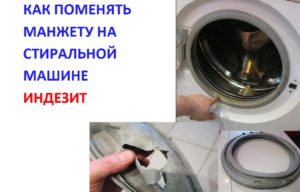 If there is a hole, abrasion or swelling on the hatch cuff of an automatic washing machine, then the elastic band urgently needs to be replaced. Such damage violates the necessary tightness and causes water to leak out of the tank when the cycle starts. And this means unfinished laundry, dirty floors and flooded neighbors.
If there is a hole, abrasion or swelling on the hatch cuff of an automatic washing machine, then the elastic band urgently needs to be replaced. Such damage violates the necessary tightness and causes water to leak out of the tank when the cycle starts. And this means unfinished laundry, dirty floors and flooded neighbors.
Replacing the cuff on an Indesit washing machine will take no more than an hour, and all you need to do is open the door and prepare a minimum of tools. The main thing is to first turn off the power and follow the instructions exactly. And detailed algorithms for dismantling a damaged part, installing a new rubber band and preventive measures are given below.
Removing the damaged part
A damaged hatch cuff is not a death sentence for a washing machine. On the contrary, such repairs will cost much less than replacing a control module or damaged electronics. And what’s even nicer is that almost every owner of the Indesit model can remove the rubber band from the drum with their own hands and install a new one.
The first step is to prepare for replacement: purchase a new cuff identical to the damaged one, focusing on the diameter, markings and recommendations of the consultant in the store. Next, we take care of our own safety: disconnect the machine from the electrical network and wipe the body with a dry cloth. After this, we proceed directly to dismantling.
- Remove the fixing clamps. If the holders are plastic, then, holding the junction of the two latches, pull forward, and with metal rims, unscrew the screw or pry off the spring with a flat screwdriver.
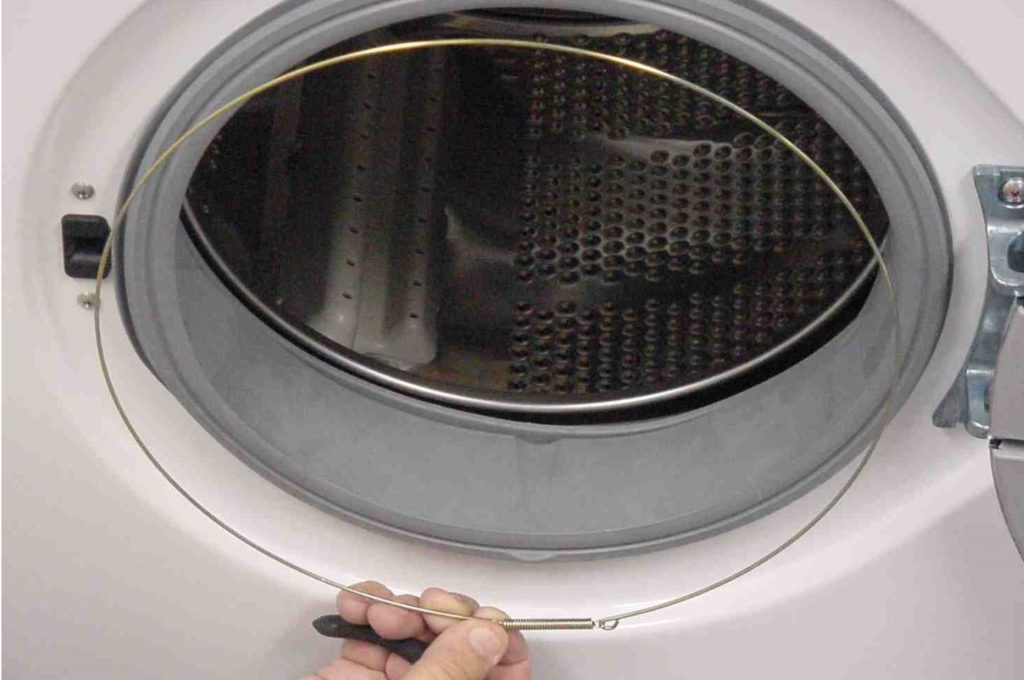
- Carefully pull out the front part of the rubber gasket.

- We are looking for a mounting mark indicating the required location of the cuff to the drum of the washing machine (most often the mark will be a characteristic protrusion).
- We mark the response mark on the body with a marker.
- Pull the elastic towards you and remove it from the recess.
After removing the old seal, do not rush and install a new part. It is important to thoroughly clean the cuff edge from dirt, scale and detergent residues. A richly soaped sponge is perfect for these purposes, and the soap will become not only a cleaning agent, but also a lubricant.
Important! There is no need to rinse off the foam and wipe the recess dry: the slippery solution will help speed up the installation process.
Instructions for installing a new rubber band
To put the rubber seal of the hatch back on the drum, you will have to try a little. The factory cuff is quite elastic and dense, and provides strong “resistance” during installation, which often causes difficulties for amateur craftsmen. The following instructions will help you deal with the rubber band:
- The new cuff is applied to the seat so that the mounting marks on the gasket and tank correspond to each other.
- Replacement begins from the top edge, holding the inserted section with one hand while the other pulls the elastic onto the edge.
- Next, the inner edge is put on, starting from the center and moving in turn in both directions.
- At the bottom, the cuff is tightly stretched over the tank.
- The gasket is felt along its entire length and finally pressed into the edge for a tight fit to the body of the washing machine.
- The alignment of the mounting marks is checked. If displacement occurs, it is recommended to remove the elastic band and repeat the procedure from the beginning.
For convenience, it is better to remove the front door to provide free access to the washing machine.However, it is worth remembering that for Indesit models, the cuff can be replaced without a cleared opening.
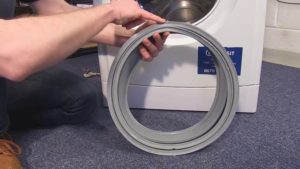 The most difficult stage is the installation of the internal clamp. The installation method depends on the type of holder. For example, for washing machines with metal clamps on the screws, you will need to loosen the clamps, and then firmly place the rim in its seat. With plastic latches, it is enough to loosen the holders by pressing on the junction of the “tails”, pull the elastic band over the edge and fasten the clamp back. If the washer has a wire fastening without tensioners, you need to place it evenly along its entire length, tighten the ends with pliers, and hide the resulting knot in a special protrusion on the cuff. The most difficult thing is to deal with the spring tension, for which you need to insert a flat-head screwdriver into the hatch blocking hole, pry off the spring and put on the bracket.
The most difficult stage is the installation of the internal clamp. The installation method depends on the type of holder. For example, for washing machines with metal clamps on the screws, you will need to loosen the clamps, and then firmly place the rim in its seat. With plastic latches, it is enough to loosen the holders by pressing on the junction of the “tails”, pull the elastic band over the edge and fasten the clamp back. If the washer has a wire fastening without tensioners, you need to place it evenly along its entire length, tighten the ends with pliers, and hide the resulting knot in a special protrusion on the cuff. The most difficult thing is to deal with the spring tension, for which you need to insert a flat-head screwdriver into the hatch blocking hole, pry off the spring and put on the bracket.
The installation ends by putting on the outer clamp. This is done in two ways. In the first, it is proposed to grasp the rubber at both ends of the spring, and, stretching and maintaining tension, press it until it is completely seated in the existing recess. The second option is to lock onto one end of the spring and pull the rim in one direction only.
Attention! Only old clamps that are not damaged can be reinstalled. If defects, cracks, chips, or bends appear, it is important to replace the holders with new ones.
If everything was done correctly and carefully, the cuff and clamp should fit snugly into place. It’s easy to check the quality of work: just conduct a tank leak test. This is done very simply:
- use a ladle to draw water into the drum up to the border of the lower seal;
- start the fastest washing mode.
If there are no leaks (even drops under the door), it means that the cuff was installed correctly. Otherwise, it is necessary to drain the water, inspect the tightness of the rubber band to the edge, tighten the clamp more tightly and test the machine again for leaks. If it leaks again, you will have to remove the seal and reinstall it.
Why does a cuff deteriorate?
 In order not to make a regular replacement, it is important to “work on the mistakes” and identify the cause of damage to the gum. No one has canceled natural wear and tear, but often the cuff of Indesit washing machines suffers due to the carelessness, negligence and lack of education of its owner.
In order not to make a regular replacement, it is important to “work on the mistakes” and identify the cause of damage to the gum. No one has canceled natural wear and tear, but often the cuff of Indesit washing machines suffers due to the carelessness, negligence and lack of education of its owner.
The seal, like any other part of the machine, has its own safety margin, but its service life is greatly reduced due to specific negative factors. It is not difficult to determine the source of a crack or abrasion: just carefully inspect the old gasket. Afterwards, all that remains is to select the cause of the malfunction that is suitable in nature and direction:
- constant friction against solid elements, metal parts of clothes being washed, shoes, heavy things;
- foreign objects (nails, keys) getting into the drum;
- fungus, mold and plaque that worsens the general condition of the rubber;
- inaccurate loading and unloading of laundry, leading to serious mechanical damage.
Aggressive detergents, continuous use of the unit, strong vibration during spinning and high water temperatures also have a destructive effect on the cuff material.To avoid accelerated wear of the part, it is recommended to regularly clean and dry the seal, carefully check the pockets of items being washed, and not exceed the permissible dosage of powder, concentrates and cleaning compounds.
Ideally, before each wash, you should carefully inspect the cuff for flaws and defects. Even a minor crack in the seal is considered a serious leak and requires immediate replacement. If it is not possible to replace the damaged gasket in a timely manner, it is recommended to repair the part - sealing the damaged area with a suitable patch.
Important! Gluing a patch is only a temporary measure. A defective rubber band should be replaced as soon as possible.
It is not recommended to joke with the tightness of the machine, therefore, if there is any suspicion of a damaged cuff, the situation must be corrected immediately. You can assess the size of the flaw, dismantle the damaged seal and install a new rubber band yourself. Moreover, all the necessary tips and instructions are described in detail in this article.
Interesting:
Reader comments
- Share your opinion - leave a comment
Categories
Washing machine repair


For buyers

For users

Dishwasher


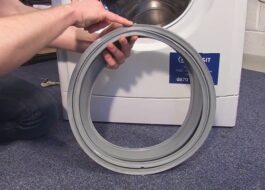

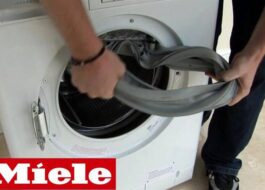

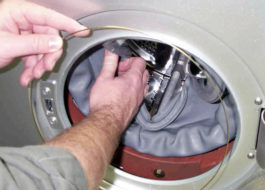










Add a comment